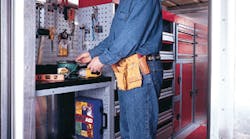Durability and accessible cargo space are attracting electrical contractors to walk-in trucks.
Walk-in trucks have long been the vehicle of choice for deliveries — UPS and FedEx trucks may be the most ubiquitous walk-in trucks on the road. Now, the same features that make walk-ins popular for deliveries are attracting the interest of electrical contractors.
Jim Breading is among their ranks. The owner of Service Electric Company, Warsaw, Ind., has been driving a 14-ft walk-in truck for 15 yr. He likes the truck's accommodating design, which provides direct access from the cab to a workshop he's set up in the cargo area.
“I've got a workbench with a big vise on it so I can thread or saw pipe,” he says.
In addition to the vise, he hauls hundreds of parts, fittings, and equipment in the truck. “It saves us one heck of a lot of trips back to the shop,” he says. “I used to have a pickup truck with just boxes on the side, and you were forever running someplace just to get material or a tool or something you couldn't carry.
“On this truck, I carry knock-out punches, a small bandsaw, drills, tools, extension cords, levels — whatever a normal electrician needs, I can carry. I've got shelves for parts and toolboxes, and I carry a 6-ft ladder and a 16-ft extension ladder inside. I carry almost a small store in there.”
His walk-in's size fits what he needs to carry, yet allows him the maneuverability he needs on the road. It has an aluminum body, and Breading appreciates how long the truck has lasted. “Before, we were trading trucks every 4 yr because they would rust out,” he says.
Bill Lewis shares Breading's enthusiasm for the trucks. He began looking at walk-ins about a decade ago. Today, the owner of Hobbs Electric, Melbourne, Fla., owns 14 walk-ins. He favors the trucks for several reasons:
-
Ease of access. Lewis' crews back the trucks up to jobsites and go in and out of the back doors. They don't need to unload all their supplies to access those they need.
-
Fewer damaged materials. In other vehicles, Lewis' workers stacked supplies on the floor and piled ladders or scaffolding on top, damaging goods in the process. In the walk-ins, his men shelve supplies, which leaves room for the ladders.
-
Longevity. Lewis has some walk-ins close to 10 yr old that still function well. They look good and act as mobile billboards for his business.
Lewis' staff likes the trucks, too. A few summers ago, they held a golf tournament. The prize? The winners got to drive the new walk-ins that year.
Photo courtesy of Workhorse Custom Chassis




